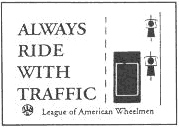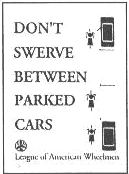Traffic laws in most jurisdictions direct bicyclists to ride "as far to the right
as is practicable." So how far right is that?
It doesn't mean you have to ride in the gutter and dodge drain grates, glass, and
gravel. It does mean you need to ride far enough to the right to allow traffic to
pass -- if it safe for you to do so. And you get to decide whether or not
it's safe. The Uniform Vehicle Code and many state codes require travelers proceeding
at a slower pace than other traffic to keep to the right to facilitate overtaking
and promote smooth traffic flow. This is an ordinary courtesy made into law, and
it applies to motor vehicle operators, equestrians, and bicyclists.
 Because bicycles are narrow vehicles, it is often possible to share a traffic lane
with a motor vehicle. However, if the lane is too narrow for you to safely share,
ride far enough to the left to fully occupy the lane. (In the right-hand tire track
is a good spot.) Overtaking motorists will not be able to squeeze past you and remain
in the lane, so they will have to acknowledge that they are passing another vehicle,
wait for oncoming traffic to clear, and pull across the center line.
Because bicycles are narrow vehicles, it is often possible to share a traffic lane
with a motor vehicle. However, if the lane is too narrow for you to safely share,
ride far enough to the left to fully occupy the lane. (In the right-hand tire track
is a good spot.) Overtaking motorists will not be able to squeeze past you and remain
in the lane, so they will have to acknowledge that they are passing another vehicle,
wait for oncoming traffic to clear, and pull across the center line.
NOTE: Overtaking bicyclists could still share the lane, so don't assume that you own
the lane while riding in this blocking position. Always look behind you before moving
left or right within the lane.
Here's a general rule: ride just to the right of traffic, except in a narrow lane,
when you should ride in the right hand tire track.
In a very wide lane there might be room for you to ride several feet from the curb
and still allow room for traffic to pass to your left. There are no good reasons to
move right in this situation, and several reasons why you are safer away from the
curb. You're more visible, there is more time to react to someone opening a car door
or pulling out of a driveway, and there is less trash. You're not holding up traffic
in that position, and you're doing yourself some good.
Other conditions besides the width of the lane will make a difference in how far to
 the right you will want to ride. For example: If there are parked cars or other barriers
like a wall near the right edge of the road, move left. Give yourself some room to
maneuver and time to react to conditions like a sudden gust of wind or the impatient
motorist who tries to squeeze by in the lane.
the right you will want to ride. For example: If there are parked cars or other barriers
like a wall near the right edge of the road, move left. Give yourself some room to
maneuver and time to react to conditions like a sudden gust of wind or the impatient
motorist who tries to squeeze by in the lane.
If you are moving as fast as other traffic, move left into the lane. You won't hold
anyone up since you are traveling as fast as they are, and you need extra space
around you at high speed. If you are grinding up a hill at little more than a walking
pace, move right. At slow speed it's possible to ride safely within a few inches
of the edge of the pavement.
At intersections your position in the lane can be a very effective signal to let other
drivers know which way you are going. If you are going straight or turning left, move
to the center or left side of the lane. Drivers behind you who want to turn right can
pull up to your right and make the turn without crossing your path. If you are turning
right, keep right and share the lane.
Reprinted from "Bicycle USA", magazine of the League of American
Bicyclists. Effective CyclingTM.
For more information about the League of American Bicyclists, visit
their web site, www.bikeleague.org,
or e-mail them at bikeleague@aol.com.